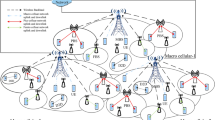Abstract
This paper presents a new analytical framework for clustered device-to-device (D2D) networks in dense urban scenarios. We model the D2D network as a Matern cluster process (MCP) instead of Poisson point process and Tomas cluster process. MCP modeling can capture both clustered and bounded properties of D2D communications in urban areas. Considering a typical D2D receiver (DR), we assume it receives the content of interest from a D2D transmitter (DT) in the same cluster. Two different choice methods of its serving DT are analyzed: (1) the serving DT is chosen uniformly at random; (2) the serving DT is the closest active DT to the typical DR. Based on this model, distributions of the serving distance and interfering distances of both choice methods are derived through geometric construction and order statistics theory, respectively. With these distance distributions, the coverage and area spectral efficiency (ASE) of the network can be obtained using stochastic geometry. According to the analysis and simulations, we know that ASE of the uniform choice can be maximized by optimizing the average number of simultaneously active DTs per cluster. Meanwhile, ASEs of both choice methods can be maximized by choosing a proper coverage threshold. This paper provides a guideline to the analysis of clustered D2D communications and can be extended to heterogeneous networks.











Similar content being viewed by others
References
Golrezaei, N., Molisch, A. F., Dimakis, A. G., & Caire, G. (2013). Femtocaching and device-to-device collaboration: A new architecture for wireless video distribution. IEEE Communications Magazine, 51(4), 96–104.
Doppler, K., Rinne, M., Wijting, C., Ribeiro, C. B., & Hugl, K. (2009). Device-to-device communication as an underlay to LTE-advanced networks. IEEE Communications Magazine, 47(12), 42–49.
Tehrani, M. N., Uysal, M., & Yanikomeroglu, H. (2014). Device-to-device communication in 5G cellular networks: Challenges, solutions, and future directions. IEEE Communications Magazine, 52(5), 86–92.
Liu, J., Kato, N., Ma, J., & Kadowaki, N. (2015). Device-to-device communication in LTE-advanced networks: A survey. IEEE Communications Surveys Tutorials, 17(4), 1923–1940. 4th Quart.
Asadi, A., Wang, Q., & Mancuso, V. (2014). A survey on device-to-device communication in cellular networks. IEEE Communications Surveys Tutorials, 16(4), 1801–1819. 4th Quart.
Andrews, J. G., Baccelli, F., & Ganti, R. K. (2011). A tractable approach to coverage and rate in cellular networks. IEEE Transactions on Communications, 59(11), 3122–3134.
Peng, M., Li, Y., Quek, T. Q. S., & Wang, C. (2014). Device-to-device underlaid cellular networks under rician fading channels. IEEE Transactions on Wireless Communications, 13(8), 4247–4259.
ElSawy, H., & Hossain, E. (2014). Analytical modeling of mode selection and power control for underlay D2D communication in cellular networks. IEEE Transactions on Communications, 62(11), 4147–4161.
George, G., Mungara, R. K., & Lozano, A. (2015). An analytical framework for device-to-device communication in cellular networks. IEEE Transactions on Wireless Communications, 14(11), 6297–6310.
Lin, X., Andrews, J. G., & Ghosh, A. (2014). Spectrum sharing for device-to-device communication in cellular networks. IEEE Transactions on Wireless Communications, 13(12), 6727–6740.
Joshi, S., & Mallik, R. K. (2017). Analysis of dedicated and shared device-to-device communication in cellular networks over Nakagami-m fading channels. IET Communications, 11(10), 1600–1609.
Jo, H. S., Sang, Y. J., Xia, P., & Andrews, J. G. (2012). Heterogeneous cellular networks with flexible cell association: A Comprehensive Downlink SINR Analysis. IEEE Transactions on Wireless Communications, 11(10), 3484–3495.
Zhou, Y., Zhao, Z., Louët, Y., Ying, Q., Li, R., Zhou, X., et al. (2015). Large-scale spatial distribution identification of base stations in cellular networks. IEEE Access, 3, 2987–2999.
Ganti, R. K., & Haenggi, M. (2009). Interference and outage in clustered wireless ad hoc networks. IEEE Transactions on Information Theory, 55(9), 4067–4086.
Chun, Y. J., Hasna, M. O., & Ghrayeb, A. (2015). Modeling heterogeneous cellular networks interference using poisson cluster processes. IEEE Journal on Selected Areas in Communications, 33(10), 2182–2195.
Afshang, M., Dhillon, H. S., & Chong, P. H. J. (2016). Modeling and performance analysis of clustered device-to-device networks. IEEE Transactions on Wireless Communications, 15(7), 4957–4972.
Afshang, M., & Dhillon H. S. (2015). Spatial modeling of device-to-device networks: Poisson cluster process meets Poisson Hole Process. In IEEE Asilomar conference on signals, systems and computers, pp. 317–321.
Afshang, M., Dhillon, H. S., & Chong, P. H. J. (2016). Fundamentals of cluster-centric content placement in cache-enabled device-to-device networks. IEEE Transactions on Communications, 64(6), 2511–2526.
Afshang, M., Saha, C., & Dhillon, H. S. (2017). Nearest-Neighbor and contact distance distributions for matern cluster process. IEEE Communications Letters, 21(12), 2686–2689.
Afshang, M., & Dhillon, H. S. (2017). Fundamentals of modeling finite wireless networks using binomial point process. IEEE Transactions on Wireless Communications, 16(5), 3355–3370.
Azimi-Abarghouyi, S. M., Makki, B., Haenggi, M., Nasiri-Kenari, M., & Svensson, T. (2017). Stochastic geometry modeling and analysis of single- and multi-cluster wireless networks. https://arxiv.org/abs/1712.08784.
Stoyan, D., Kendall, W. S., & Mecke, J. (1995). Stochastic geometry and its applications (2nd ed.). New York, NY, USA: Wiley.
Guo, J., Durrani, S., Zhou, X., & Yanikomeroglu, H. (2017). Device-to-device communication underlaying a finite cellular network region. IEEE Transactions on Wireless Communications, 16(1), 332–347.
Author information
Authors and Affiliations
Corresponding author
Additional information
This work is supported by National Natural Science Foundation of China (61571234, 61631020), National Basic Research Program of China (973 Program: 2013CB329005), and Postgraduate Research and Practice Innovation Program of Jiangsu Province (KYZZ16_0257).
Rights and permissions
About this article
Cite this article
Wang, Y., Zhu, Q. Performance analysis of clustered device-to-device networks using matern cluster process. Wireless Netw 25, 4849–4858 (2019). https://doi.org/10.1007/s11276-018-1769-1
Published:
Issue Date:
DOI: https://doi.org/10.1007/s11276-018-1769-1




